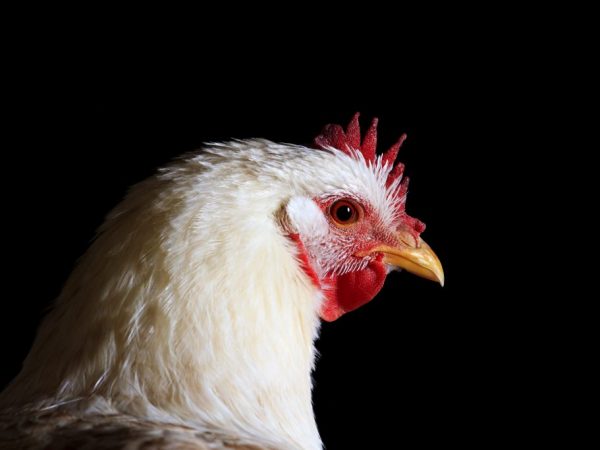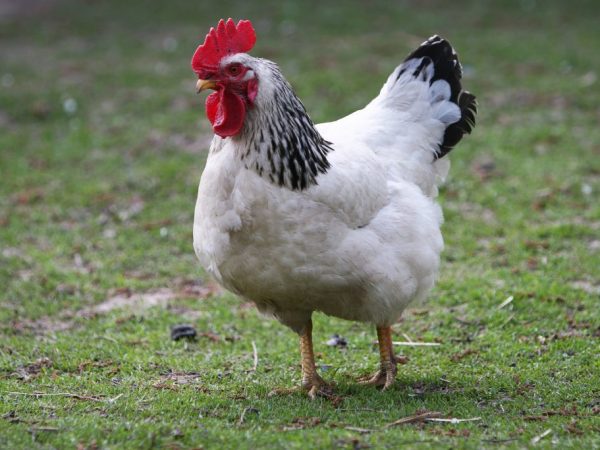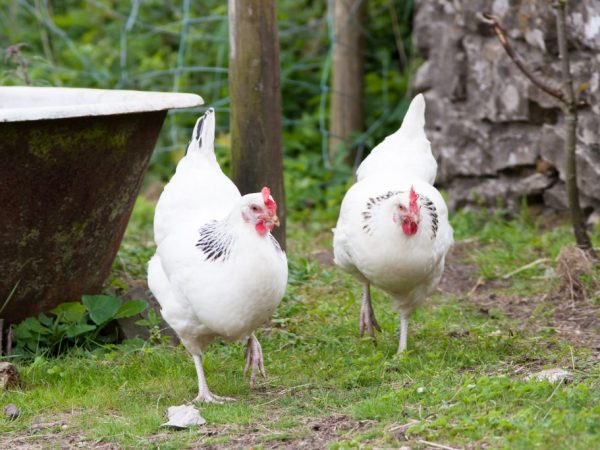Sussex chickens are a rare English breed
The breed of chickens Sussex got its name from the English county of Sussex. It was there that this ancient bird was brought to its current indicators (with its description can be found in documents from the times of the Roman Empire (1st century AD), it was). In Great Britain, she is popular, there is an amateur club, whose members maintain the purebred Sussex.

Sussex chickens are a rare English breed
Brief information about the breed
- Productivity type: meat-egg.
- Rooster weight: medium (3–3.8 kg).
- Chicken weight: medium-heavy (2.2-3 kg).
- Start of laying: early (6 months).
- Egg production: medium (190-200 eggs per year).
- Features of the: unpretentious to the conditions of keeping and feeding, resistant to diseases.
- Egg size: 55–62 g.
- Are they suitable for a beginner: Yes.
Detailed description
Sussex chickens are inexpensive. They do not occupy the first places in the ranking of the elite, but their features deserve attention.
White Cochinhin and Dorking, light Brahma and Ornington, Cornish and others took part in the formation of the breed.
Birds have an attractive appearance, they can become a decoration of any poultry yard. Plumage is different.
- Colombian color predominates: the main color is white, the neck (in the form of a beautiful necklace) and tail are black. However, they have a white border.
- Silver - black feathers with a white border cover the whole body.
- Calico - brown-red okra with light tips;
- Fawn - yellow-red feathers on the body and dark two-colored - on the neck and tail;
- With a red color, there are darker feathers on the back and tail.
It is rare to find a white color and a royal, which is similar to the Colombian, but the neck and tail are not black, but purple-lilac.
Breeders have bred dwarf varieties. Their representatives in England retained the Colombian color, and in Germany they became porcelain (brownish).
Sussexes represent the meat-egg direction, so they are quite large. The weight of the males is 3–3.8 kg, and the hens are 2.2–3. The legs are short and strong, the head is small, the body is proportionally folded.
The scallop is small, in roosters it is large, erect, with 4–5 teeth, bright red, the tail is short.
Temper
Birds have a calm, docile nature, quickly get used to the owner, and can be completely tame.
Incubation instinct
Chickens are good hens. After the appearance of chickens, they do not abandon them, they continue to take care and protect. They can sit on eggs 3 times a summer.
A distinctive feature is the ability to determine the sex of the chick immediately upon hatching: the cockerels have yellow fluff of a darker shade.
Productivity
Sussex chickens are very beneficial for keeping. They have both meat indicators and egg production at their best. Already at 3.5 months, males reach a slaughter weight of 1.5 kg, and the quality of meat does not deteriorate with the age of the bird.
Layers begin to lay at 6 months and lay up to 190-200 eggs per year, egg weight 55-62 g. Under ideal conditions of keeping and feeding, some breeders received 250 pieces. in year.
Advantages and disadvantages of the breed

Beautiful and unpretentious chickens
Sussex breeders talk about the following advantages of the breed:
- unpretentious content;
- disease resistance;
- high rates of productivity;
- docile character;
- attractive appearance.
The disadvantages include only the fact that it is difficult to acquire a real bird. Often, unscrupulous sellers under their name sell Dominant crosses with the same color or crossbreeds of birds that do not reach the declared performance indicators. And in this regard, sometimes you can hear negative reviews.
Breeding features
Incubation
Sussex hens are good brood hens. Despite their large size, they handle eggs very carefully. You can put 13-15 eggs under the chicken, incubation period 21 days. The eggs are fine for an incubator too.
Food
Chickens are fed as follows:
- in the first 10 days, crushed boiled eggs (1 pc. per 10 heads), cottage cheese with semolina, small cereals, chicken feed are given, milk powder and a crushed multivitamin tablet are added to it;
- from 3-5 days you can add chopped greens (alfalfa, clover, nettle);
- from 5-7 days friable mash is made with curdled milk, whey, fish broth;
- from day 10, boiled vegetables are allowed (potatoes, pumpkin, zucchini, carrots, etc.);
- from day 10, add crushed chalk, boiled crushed egg shells, in a separate bowl - fine gravel or coarse sand.
- compound feed for chickens, in which all nutrients are balanced, it is recommended to replace at least 50% of the diet;
- clean drinking water must be available at all times.
Chick care
The breed is characterized by a good survival rate of chickens - about 95%. They are also unpretentious and do not require any special treatment. Therefore, you need to adhere to the general rules:
- chickens should not climb into the feeders and drinkers with their feet;
- when kept without chicken, heating with an infrared lamp in the first month of life;
- you can lay paper on the floor, and on it sifted chicken feed, and later corn grits;
- the mash is placed for 30-40 minutes, after which it is removed (so that the food does not acidify);
- the first 10 days they feed every 2 hours.
Features of keeping adults
What should be a chicken coop
Since sussexes are quite large, they need a spacious chicken coop (at least 1 sq. M. For 4–5 heads). Under it, you can adapt existing buildings or build a new one from wood, brick, silicate blocks. It is desirable that the following conditions are observed in the chicken dwelling:
The walls should be insulated so that in winter the air temperature is maintained at 15 ° C (but not lower than 10 ° C). Various electric heaters are suitable for heating a small shed.
Arrange supply and exhaust or forced ventilation.
The floor is ideally cemented with an underlying fine mesh metal mesh to prevent rodents.
A simpler option is to keep birds on a deep, non-replaceable bedding, which is used as peat, straw chaff, sawdust, shavings. In winter, this will be an additional heating for the chicken coop. The underlying material is poured in a layer of 8–15 cm for 4–5 months, once a week the top layer with droppings is removed and a fresh one is added.
For good lighting, it is better to arrange windows on the southeast side (their area should be equal to a quarter of the floor area). To receive eggs in winter, an additional source of light is needed.
The lamp can be equipped with a time relay that can be set to the desired duration (12-14 hours), and the light will turn on and off automatically. Too bright will not work, one 60-watt per 10 square meters is enough. m.
Chickens should sleep on the roost - these are 5x6 cm bars with slightly rounded edges.They are installed at a height of 50 cm from the floor. If there are several of them, then it is better to fix at the same height, and not with a ladder, with a distance between neighboring 35 cm, and 25 cm from the wall. One bird will occupy at least 25 cm of the perch.
Nests are equipped in the darkest part of the chicken coop. For them, boxes with a base of 30x40 cm and a height of 30 cm, installed 40 cm from the floor, are suitable. 3-4 nests are arranged for 10 chickens.
Food

It is imperative to know the correct feed rate
In winter, birds are fed 2 times a day - in the morning with a soft warm mash, and dry grain is given at night.
On walking grounds, you can hang cabbage, nettle brooms to the walls, chickens will peck them with pleasure.
In summer, with good activity in the fresh air, they give food 1 time (in the morning), if the bird does not walk or the walking area is small - 3 times.
The chicken diet should be as follows:
- 60% - grain and grain waste;
- 30% - vegetables, raw and boiled (potatoes, beets, Jerusalem artichoke, pumpkin, zucchini, carrots, etc.);
- 10% is fresh or dried greens, hay dust, crushed spruce and pine needles (in winter), milk and dairy products.
As a winter vitamin supplement, it is useful to give sprouted grain.
As additives, crushed chalk and coal, fine gravel or coarse sand are needed. We need constant access to clean water.
Chicken feed can provide a more expensive but balanced diet.
Place for walking
Chickens should walk even in winter. The walking area is advised to do at least 2-3 times more in area than the chicken coop. She is fenced with a net: if you want, so that even sparrows do not bother the birds, use a fine-mesh one.
For protection from precipitation, some owners install a roof.
Molting
Sussexes are also prone to molting like other chickens.
Molting is a natural process. Normally, it takes place in the fall. At this moment, the bird looks ugly, disheveled, but in fact, the intensity of the change of plumage indicates good egg production.
Good layers will get new feathers in 6-8 weeks. And those that do not rush well, shed very slowly, starting from the middle of summer, everything goes unnoticed for the owner.
This period is stressful, therefore it is important to provide thorough care: add vitamins and minerals to the feed, provide a warm room and not disturb.
At the time of molting, the bird is vulnerable: it stops laying eggs and tries to be in solitude.
Possible diseases
This ancient breed of chickens has good immunity. Breeders have been working on this quality for a long time. However, if the norms of keeping and feeding are not followed, the bird can get sick. Let's consider the most common diseases.
Coccidiosis is more common in young animals. A characteristic symptom is bloody diarrhea against the background of general weakness. To stop the infection, diseased individuals are removed, and the rest are treated with special drugs, since they can also be infected.
Mycoplasmosis occurs in large farms with crowded content, high humidity and high levels of ammonia in the room. The disease affects the lungs, the bird coughs. For an accurate diagnosis of this disease, you need to do a blood test in a veterinary laboratory, and only then start treatment.
There is a vaccine against mycoplasmosis, immunity lasts 6-8 months, then they are re-vaccinated.
Lice can be very troublesome, reducing productivity. To recognize their presence, you need to examine the birds in the abdomen. An effective measure in the fight against chicken lice is bathing in a warm water solution of antiparasitic drugs. The walls of the chicken coop are treated with the same.
Downy eaters are small, wingless insects, up to 2 mm in size, with a strong infection they can completely leave chickens without feathers in places. They are easy to spot in the head area when the bird is sitting quietly. Treatment is the same as for lice.
Ascariasis is difficult, especially in young animals.If an invasion is suspected, chickens are fed antihelminthic drugs, but eggs are not recommended to be consumed within a week after treatment.
Salmonellosis is manifested by yellow-green diarrhea, through raw eggs it is transmitted to humans. There are a number of antibacterial drugs for its treatment.
It is good to arrange ash and sand baths in a walking yard under the roof, where chickens can clean themselves. Antiparasitic dusts can be added to them.
Owner reviews
Sussex breeders speak well of this breed of chicken.
It is noted that a large slaughter yield of meat is obtained from these birds at low costs. At the same time, they are unpretentious, have a high egg production for the meat and egg direction, are picky about food and are in demand (it is easy to find buyers when breeding).


